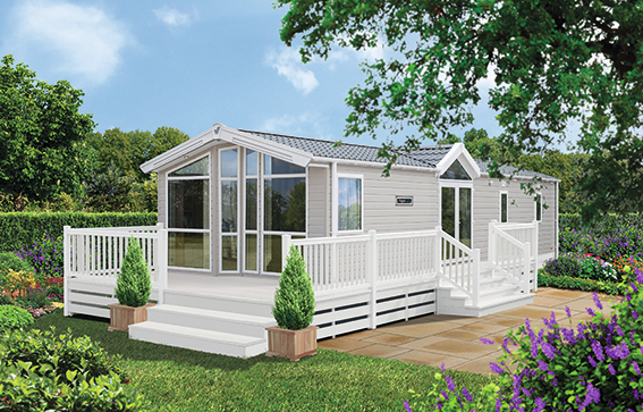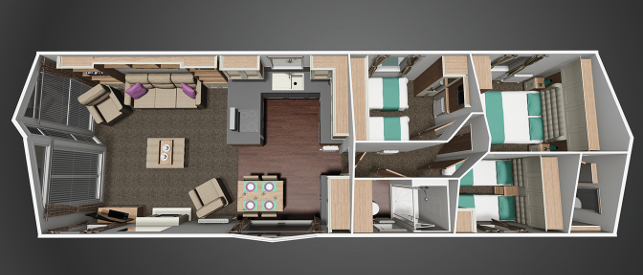
Now in its 70th year of manufacturing, Willerby has a wide model range of holiday homes, chalets and lodges including this Vogue lodge
Boasting the development of the UK’s first mass produced caravan in 1946, Willerby Homes soon outgrew its original factory in the village of Willerby and in 1989 this family run firm relocated to a sprawling 90 acre site in nearby Hull.
Today its employee base has grown to over 1,000, some of whom include designers, engineers and craftsmen that have been with the company for decades.
And although it no longer manufactures caravans, its portfolio includes a wide range of holiday homes, chalets and lodges in a variety of sizes and specifications all of which are designed, developed and assembled at the Hull site. In fact, 6,500 units leave the
factory each year.
With the leisure industry representing over £1.8 billion in the UK alone, Willerby is keen to maintain its leadership in the market and provide true innovation and value for money for its wide ranging customer base.
As a result, the company has expanded and improved its product range and manufacturing capability in recent years. However, this hasn’t been without challenges — which have had serious impacts on the efficiency of the company’s processes and production lines.
According to Willerby’s design director, Barry Hague, the issues were widespread throughout the organisation, from the initial concept development to production.
“If we look back 18 months ago, there were multiple things that, as a business, we needed to address including taking designs into production,” says Hague.

A 3D view of a three bed holiday home
Previous process
Willerby’s New Product Development (NPD) process is split into two stages.
The design team develops the new models and produces a full set of detailed instructions.
The engineering team then creates the full production drawings, bill of material, product prototype and guides the first production batch, typically ten units, through the production process to find, locate and eradicate any issues.
Willerby’s key performance indicators (KPIs) for this process are drawing error rate and percentage completion off the line.
As Alan Bateman, technical director, explains: “Essentially, it’s all about drawing quality and completion.
We’re following the process through, using production quality information, from the prototype stage in to production. That’s when our KPIs really kick in.
“Once we go to production, the first batch is key and we monitor whether it’s 100% complete off the line. We build the first batch of 10 products on the line, monitor completion; find any issues that prevent the product from being 100% complete. We also monitor the number of non conformances or drawing defects.”
According to him, the team was also seeing up to 54 nonconformances reports (NCRs) per first production batch and it was unlikely that the product would be finished.
Realising that non-conformance factors held huge potential to boost both efficiency on the production line as well as improvements and visibility of quality information, the company started looking for a management solution with the aim of providing process improvement and efficiency gains.
“One of the biggest issues for Willerby has been the fast pace of design change and that has caused us to have issues with Bill of Materials accuracy,” says Howard Dawson, IT Manager at Willerby.
“We initially began looking at an ERP (Enterprise Resource Planning) solution, but it quickly became apparent that a PLM (Product Lifecycle Management) system would allow us to build a controlled New Product Introduction process and have better quality information.”

Willerby’s customers demand comfort both inside and out
PLM solution
As Willerby has been using both Autodesk Inventor and Autodesk Vault to create and manage its product data for the last eight years, it engaged with the vendor to investigate its PLM 360 Product Lifecycle Management solution.
Part of Dawson’s attraction to PLM 360 was the cloud based nature of the solution. “We manufacture holiday homes and didn’t want to get ourselves involved in the pain of a big IT implementation,” he comments.
“We have a small IT team and having an on-premise solution would be overly complicated and take up too much time and too many resources — so a cloud-based solution was a natural choice.
“We also wanted to make sure that the solution is not owned by IT. It’s business software to be used throughout the business, our aim always was to move the processes out into the business to take control and ownership of them, rather than IT being the bottleneck and only resource for the implementation.”

The Portland lodge
The result
Only 12 months after beginning its implementation of PLM 360, Willerby is already reaping the benefits of a more controlled and readily visible set of processes and quality metrics during its New Production Introduction process.
According to Bateman, in an average month Willerby can manage 34,000 line items, based on 110 production batches over five production lines.
“We’re now able to measure the defects straight off the system and take that information to create a separate report that tells us our performance, month-on-month, for the last 12 months,” explains Bateman.
“Over the last 20 prototypes, we’re averaging about six NCRs compared to 54 before we implemented PLM 360.
If you look at accuracy of information, BOM accuracy of 99.6%, with drawing accuracy of 99.2%, compared to 12 months ago.”
With PLM 360 providing valuable quality and efficiency gains alongside greater visibility of the company’s performance, the ultimate question is “Where next for Willerby and PLM 360?”
Dawson explains that “Willerby are still on the journey with PLM 360 and we haven’t fully got to where we need to go. We’re looking at the concept design stage and controlling that with tasks and projects.
“We then need to move onto our master data and control much more of that through PLM 360, together with anywhere else in the business that needs a workflow and approval. These will be transferred across to PLM 360 in time.”
As design director, Barry Hague concludes: “For me, it’s freeing up the relevant people in the business to be able to do their primary roles, rather than having to have them run around, chasing whether something is approved or looking for that information, asking ‘How do I find out where it’s used?’.”
Willerby Holiday Homes implements PLM360
Default






